Cyril Ponnamperuma
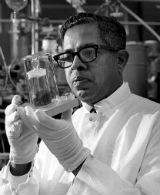 Cyril Ponnamperuma was born in Galle, Sri Lanka on 16 October 1923. He studied at St. Aloysius' College, Galle and subsequently at St. Joseph's College, Colombo. He obtained his Bachelor of Arts degree in philosophy from the University of Madras. He obtained a Bachelor of Science degree in chemistry in 1959 at Birkbeck, University of London. In 1962, he received a doctorate in chemistry from the University of California, Berkeley under the direction of the Nobel Laureate Melvin Calvin.
Cyril Ponnamperuma was born in Galle, Sri Lanka on 16 October 1923. He studied at St. Aloysius' College, Galle and subsequently at St. Joseph's College, Colombo. He obtained his Bachelor of Arts degree in philosophy from the University of Madras. He obtained a Bachelor of Science degree in chemistry in 1959 at Birkbeck, University of London. In 1962, he received a doctorate in chemistry from the University of California, Berkeley under the direction of the Nobel Laureate Melvin Calvin.
In 1962, he was honored with a National Academy of Science resident associateship with NASA at Ames Research Center. In 1963 he joined NASA's Exobiology Division and took over the helm of the Chemical Evolution Division. He was selected as the principal investigator for analysis of lunar soil brought to earth by Project Apollo. Thereafter, he was closely involved with NASA in the Viking and Voyager programmes and was offered membership in both the Space Science Advisory Council and Life Sciences Advisory Council of NASA.
According to Arthur C. Clarke, "No other scientist of Sri Lankan origin was internationally known and respected as he was". He produced over 400 scientific publications and held a number of prestigious academic posts during his rather short lifespan.
Sarath Gunapala
 Sri Lanka Ranajana Sarath Gunapala, was born in Yatiyantota, Kegalle. He studied at Nalanda College, Colombo, Sri Lanka (1966 – 1974/ Grade 6- 12). He obtained his Ph.D. for Physics from University of Pittsburgh, 1985, M.S. in Physics from University of Pittsburgh and B.S. in Physics from University of Colombo, Sri Lanka, 1979.
Sri Lanka Ranajana Sarath Gunapala, was born in Yatiyantota, Kegalle. He studied at Nalanda College, Colombo, Sri Lanka (1966 – 1974/ Grade 6- 12). He obtained his Ph.D. for Physics from University of Pittsburgh, 1985, M.S. in Physics from University of Pittsburgh and B.S. in Physics from University of Colombo, Sri Lanka, 1979.
Gunapala joined NASA in 1992 after working at AT&T Bell Laboratories. He is a solid-state physicist, senior research scientist and group supervisor at NASA's Jet Propulsion Laboratory. He works primarily in Quantum Well Infrared Photo Detecting. He is also a board member of Quantum Well Infrared Photodetector Technologies LLC.
Chandre Dharma-wardana
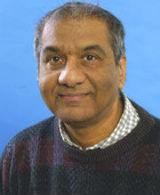 Chandre Dharma-wardana was born in Colombo. He educated at Aluthgama Vidyalaya, Ananda College and at Royal College, Colombo. He earned a BSc (Hon.) from the University of Ceylon in 1961. He earned his PhD from The University of Cambridge, (Corpus Christi College).
Chandre Dharma-wardana was born in Colombo. He educated at Aluthgama Vidyalaya, Ananda College and at Royal College, Colombo. He earned a BSc (Hon.) from the University of Ceylon in 1961. He earned his PhD from The University of Cambridge, (Corpus Christi College).
He is currently a professor of theoretical physics at the University de Montréal. He is also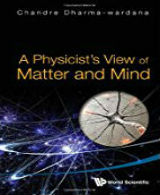 currently a principal research scientist at the National Research Council of Canada. He works on various topics in quantum theory, statistical mechanics, and solid state physics associated with Raman scattering, energy-relaxation and phonons in nanostructures, quantum Hall effect, the physics of nanotubes and graphene. His works on the construction of the classical-map scheme for quantum systems is a ground-breaking work, leading to the formulation of the classical-map hyper-netted chain method (CHNC). This method has led to a new approach for the evaluation of properties of Fermi liquids and warm-dense matter. His most recent book on physics titled "A Physicist's View of Matter and Mind", published in 2013 by World Scientific.
currently a principal research scientist at the National Research Council of Canada. He works on various topics in quantum theory, statistical mechanics, and solid state physics associated with Raman scattering, energy-relaxation and phonons in nanostructures, quantum Hall effect, the physics of nanotubes and graphene. His works on the construction of the classical-map scheme for quantum systems is a ground-breaking work, leading to the formulation of the classical-map hyper-netted chain method (CHNC). This method has led to a new approach for the evaluation of properties of Fermi liquids and warm-dense matter. His most recent book on physics titled "A Physicist's View of Matter and Mind", published in 2013 by World Scientific.
Chandra Wickramasinghe
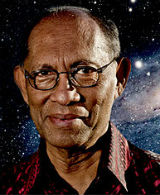 Nalin Chandra Wickramasinghe (born 20 January 1939, Colombo) is a Sri Lankan-born British mathematician, astronomer and astrobiologist. He studied at Royal College, Colombo. he graduated in 1960 at the University of Ceylon with a BSc First Class Honors in mathematics, and obtained his PhD and ScD degrees at Trinity College and Cambridge respectively. His research interests include the interstellar medium, infrared astronomy, light scattering theory, applications of solid-state physics to astronomy, the early Solar System, comets, astrochemistry, the origin of life and astrobiology.
Nalin Chandra Wickramasinghe (born 20 January 1939, Colombo) is a Sri Lankan-born British mathematician, astronomer and astrobiologist. He studied at Royal College, Colombo. he graduated in 1960 at the University of Ceylon with a BSc First Class Honors in mathematics, and obtained his PhD and ScD degrees at Trinity College and Cambridge respectively. His research interests include the interstellar medium, infrared astronomy, light scattering theory, applications of solid-state physics to astronomy, the early Solar System, comets, astrochemistry, the origin of life and astrobiology.
Wickramasinghe published the first definitive book on Interstellar Grains in 1967. He has made many contributions to this field, publishing over 350 papers in peer-reviewed journals, over 75 of which are in Nature. Fred Hoyle and Wickramasinghe ((As a student and collaborator of Fred Hoyle) further proposed a radical kind of panspermia that included the claim that extraterrestrial life forms enter the Earth's atmosphere and were possibly responsible for epidemic outbreaks, new diseases, and genetic novelty that Hoyle and Wickramasinghe contended was necessary for macroevolution.
Paules Edward Pieris Deraniyagala
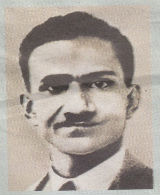 Edward Pieris Deraniyagala was born in 1900 in Colombo. He is a zoologist, paleontologist, and also an artist. He earned his BA and MA from the University of Cambridge, and obtained another MA from Harvard University in 1924. Dr. Deraniyagala specialized in fauna and human fossils of the Indian subcontinent. From 1939 to 1963 he was the Director of the National Museum of Ceylon, and from 1961 to 1964 he was the Dean of the Faculty of Arts at the Vidyodaya University.
Edward Pieris Deraniyagala was born in 1900 in Colombo. He is a zoologist, paleontologist, and also an artist. He earned his BA and MA from the University of Cambridge, and obtained another MA from Harvard University in 1924. Dr. Deraniyagala specialized in fauna and human fossils of the Indian subcontinent. From 1939 to 1963 he was the Director of the National Museum of Ceylon, and from 1961 to 1964 he was the Dean of the Faculty of Arts at the Vidyodaya University.
His fossil and species depictions included the cannibalistic Balangoda Man, the extinct Sri Lankan lion, the extinct Sri Lankan gaur, the extinct Sri Lankan hippopotamus, and the extinct Sri Lankan rhinoceros. He also published a new genus name for Chinese Alligator and described many new species of lizards and snakes for the field of herpetology. Dr. Deraniyagala served as the President of the Ceylon Branch for the Royal Asiatic Society from 1952-1955.
Mohan Munasinghe
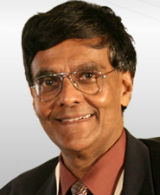 Prof. Munasinghe is the first Sri Lankan to win a Nobel Prize. He is a physicist, an academic, and an economist who was a Vice-Chair of the Intergovernmental Panel on Climate Change (IPCC) that shared the Nobel Peace Prize in 2007. He completed his school education from Royal College, Colombo, and obtained his BA honors in Engineering in 1967 and later his Masters degree from the University of Cambridge, UK.
Prof. Munasinghe is the first Sri Lankan to win a Nobel Prize. He is a physicist, an academic, and an economist who was a Vice-Chair of the Intergovernmental Panel on Climate Change (IPCC) that shared the Nobel Peace Prize in 2007. He completed his school education from Royal College, Colombo, and obtained his BA honors in Engineering in 1967 and later his Masters degree from the University of Cambridge, UK.
Prof. Munasinghe also holds the SM and Professional EE degrees in Electrical Engineering from the Massachusetts Institute of Technology, USA, a PhD degree in Solid State Physics from McGill University, Canada, and an MA degree in Development Economics from Concordia University, Canada. Prof. Munasinghe is the author of over one hundred scholarly books, and about three hundred technical papers in well-known scientific journals on climate change, disasters, environment, sustainable development, energy, transport, urban infrastructure, water resources, telecommunications, and sustainable consumption and production.
A. N. S. Kulasinghe
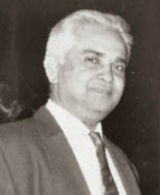 Kulasinghe was born in Udammita in Ja-Ela. He first studied at Wadduwa English Boys College and then moved to Mari Stella College, Negambo thereafter he entered to St. Benedicts' College Kotahena for his advanced level studies. He entered the Ceylon Technical College to study for the BSc in Engineering of the University of London, there he won the Sri Chandrasekera Scholarship. He gained Associate Membership of the Institution of Civil Engineers (AMICE) in 1946.
Kulasinghe was born in Udammita in Ja-Ela. He first studied at Wadduwa English Boys College and then moved to Mari Stella College, Negambo thereafter he entered to St. Benedicts' College Kotahena for his advanced level studies. He entered the Ceylon Technical College to study for the BSc in Engineering of the University of London, there he won the Sri Chandrasekera Scholarship. He gained Associate Membership of the Institution of Civil Engineers (AMICE) in 1946.
Kulasinghe focused on cost technologies, innovative construction techniques and utilization of local resources in his Engineering pursuits. His pioneering efforts and contributions in the areas of Pre-cast concrete, Pre-stressed concrete, alternate low cost construction material, ferro-cement boat building, and applications of the Shell design theory in the construction are applied in several key engineering structures in Sri Lanka.
He helped construct the Kotmale Mahaweli Maha Seya and the Buddha Jayanthi Chaithya at the Colombo harbour. The Polgolla Bund, State Engineering Corporation head office and the Colombo Planetarium were also designed by Kulasinghe.
Ray Wijayawardane
 Deshamanya Vidya Jyothi Dr Philip Revatha "Ray" Wijewardene was born in Colombo. He had his primary and secondary education at CMS Ladies’ College, Colombo, and St Thomas’ College Mount Lavinia. He proceeded to Peterhouse, University of Cambridge, UK, where he studied three branches of engineering—aeronautical, mechanical and agricultural, and earned the degree of M.A. (Cantab). He also qualified as a Chartered Engineer in the UK and Sri Lanka, and later followed a course in business administration at the Harvard Business School.
Deshamanya Vidya Jyothi Dr Philip Revatha "Ray" Wijewardene was born in Colombo. He had his primary and secondary education at CMS Ladies’ College, Colombo, and St Thomas’ College Mount Lavinia. He proceeded to Peterhouse, University of Cambridge, UK, where he studied three branches of engineering—aeronautical, mechanical and agricultural, and earned the degree of M.A. (Cantab). He also qualified as a Chartered Engineer in the UK and Sri Lanka, and later followed a course in business administration at the Harvard Business School.
He is an Engineer, Aviator, Inventor and Olympian athlete. He was an authority on tropical farming and natural resource management. He also invented a number of devices to assist small farmers in developing countries. In 1955, Wijewardene designed a two-wheeled, walking tractor to help small farmers in the tropics to mechanise their work. An early attempt to mechanize farm labour during the Green Revolution, it was manufactured and marketed worldwide by the Landmaster company in Nottingham, UK.
V. K. Samaranayake
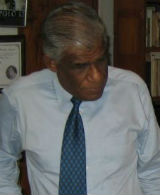 Vidya Jyothi V. K. Samaranayake, MBCS, MCS (SL), FNASSL, MIEEE (1939 – 6 June 2007) was born in Colombo. He educated at Ananda College and at Royal College, Colombo.
Vidya Jyothi V. K. Samaranayake, MBCS, MCS (SL), FNASSL, MIEEE (1939 – 6 June 2007) was born in Colombo. He educated at Ananda College and at Royal College, Colombo.
He pioneered computing & IT development industry and its usage in Sri Lanka and thus considered as the "Father of Information Technology" in Sri Lanka. He was a Professor of Computer Science and former Dean of the Faculty of Science, University of Colombo. Prof Samaranayake played a major role in the development of IT and IT related education in Sri Lanka. He was at the time of his death the chairman of the Information and Communication Technology Agency (ICTA) of Sri Lanka and was the founding and former director of the University of Colombo School of Computing (UCSC).
Nalin Samarasinha
 Dr. Nalin Samarasinha is a Sri Lankan born Astronomer based in United States of America. Nalin earned a BSc First Class Honors in Physics from University of Colombo after schooling at Nalanda College Colombo. Later he gained a MSc in astronomy from University of Maryland, College Park USA and followed it up furthering studies graduating with a PhD in Astronomy from the same University in USA.
Dr. Nalin Samarasinha is a Sri Lankan born Astronomer based in United States of America. Nalin earned a BSc First Class Honors in Physics from University of Colombo after schooling at Nalanda College Colombo. Later he gained a MSc in astronomy from University of Maryland, College Park USA and followed it up furthering studies graduating with a PhD in Astronomy from the same University in USA.
Currently he works as a Senior Scientist for Planetary Science Institute. Dr. Samarasinha’s research interests are focused on the study of comets and other small bodies of the solar system. His studies include understanding the physics and chemistry of cometary nuclei and comae, including rotational studies of nuclei and interpretation of coma morphologies, the structural properties of small bodies in the solar system, the rotational and physical properties of Trans-Neptunian objects, and the physical properties of asteroids. In 2002, The International Astronomical Union renamed Asteroid (12871) 1998 ML37 found by Lowell Observatory as Asteroid (12871) Samarasinha in honor of Dr Nalin Samarasinha. Dr Samarasinha is the first native born citizen of Sri Lanka to gain the distinction of having an Asteroid named after him.
Kirthi Tennakone
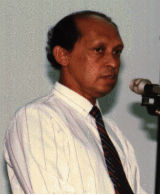 Born 1940 in a Village in Sri Lanka near the town of Veyangoda, he was exposed rural environment in early childhood. He received primary education at the Central College, Veyangoda, Sri Lanka.
Born 1940 in a Village in Sri Lanka near the town of Veyangoda, he was exposed rural environment in early childhood. He received primary education at the Central College, Veyangoda, Sri Lanka.
His research interests are in theoretical and experimental physics, chemistry and biological systems. He has authored over 350 publications covering a diverse variety of disciplines. He is the former Director of Institute of Fundamental Studies, Sri Lanka (now named as National Institute of Fundamental Studies) and the first Professor of Physics at the University of Ruhuna, Sri Lanka. He pursued studies leading to a doctoral degree in Theoretical Physics at the University of Hawaii under supervision of Sandip Pakvasa was a first suggest that neutrinos may be massive and consider the astrophysical implications. In Condensed Matter Physics he pioneered the studies on semiconducting properties Copper (I) Thiocyanate, a rare example of a transparent p-type semiconductor, currently adopted in many devices and developed techniques of its deposition as thin films. He was the first to introduce the concept of the dye-sensitized solid state solar cell and demonstrate a working prototype of the same. Sri Lanka Government recognized his contribution to research and education and awarded National Honors on two occasions (“Vidya Nidhi” in 1986 and “Desha Bandu” in 2005). He was one of the Union of Concerned Scientists who signed to the document presented to world leaders in 1992 about environmental degradation that threatens global life support systems on this planet.
Bandula Wijay
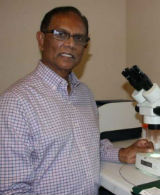 Bandula Wijay was born in Galle. He received his engineering education at Jadavpur University in Kolkata, India; then, at the University of Southern California, he received two masters degrees and a doctorate in chemical engineering. Dr. Bandula Wije is an inventor, scientist, engineer and a businessman who has developed a variety of interventional cardiovascular and other medical devices including the Protected Coronary Balloon Angioplasty (PPTCA)
Bandula Wijay was born in Galle. He received his engineering education at Jadavpur University in Kolkata, India; then, at the University of Southern California, he received two masters degrees and a doctorate in chemical engineering. Dr. Bandula Wije is an inventor, scientist, engineer and a businessman who has developed a variety of interventional cardiovascular and other medical devices including the Protected Coronary Balloon Angioplasty (PPTCA)
Since 1982, Wijay has patented 28 medical devices, and he has another seven patents in the pipeline. "My main focus now," he says, "is on the prevention of infection in implanted devices, such as tissue expanders, and in developing stents that will be used to close body lumens."
I. M. Dharmadasa
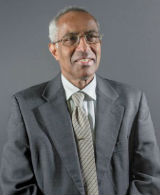 I M Dharmadasa graduated from University of Peradeniya in Sri Lanka by completing two BSc Honors degrees covering Chemistry, Physics and Mathematics. After winning an open commonwealth scholarship in 1977, he completed his PhD thesis in 1980 at University of Durham.
I M Dharmadasa graduated from University of Peradeniya in Sri Lanka by completing two BSc Honors degrees covering Chemistry, Physics and Mathematics. After winning an open commonwealth scholarship in 1977, he completed his PhD thesis in 1980 at University of Durham.
Professor Dharmadasa is a Senior Staff Grade Professor in Electronic Materials and Devices at Sheffield Hallam University. His research focuses on the development of next generation, low-cost and high-efficiency solar cells. He has nearly four decades of experience in both industry and academia. He has published over 250 articles including a single authored book on 'Advances in Thin Film Solar Cells' and his work has secured six patents, based on novel process developments. He has also proposed two new scientific models concerning development of photovoltaic solar cells.
Asha de Vos
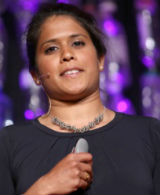 Asha de Vos is a Sri Lankan marine biologist, ocean educator and pioneer of blue whale research within the Northern Indian Ocean.
Asha de Vos is a Sri Lankan marine biologist, ocean educator and pioneer of blue whale research within the Northern Indian Ocean.
Asha's primary education was at Ladies’ College, Colombo and after completing her primary education, she moved to Scotland for her undergraduate studies in marine and environmental biology at the University of St. Andrews. She went on to gain her masters in integrative bio-sciences at the University of Oxford and a PhD from the University of Western Australia
She had served as a Senior Programme Officer in the marine and coastal unit of the International Union for Conservation of Nature. She founded the Sri Lankan Blue Whale Project in 2008. She is an invited member of the IUCN Species Survival Commission’s Cetacean Specialist Group. Asha is a TED Senior Fellow, a Duke University Global Fellow in Marine Conservation and has been selected as a Young Global Leader by the World Economic Forum. In 2013, she received the President's Award for Scientific Publications.
Tissa H. Illangasekare
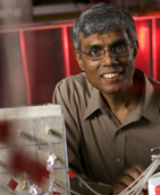 Dr. Illangasekare received a BSc (Honors) degree in civil engineering (1971) from the University of Ceylon, an M.Eng. degree in hydrology and water resources development from the Asian Institute of Technology (1974), and a Ph.D. (1978) in Civil Engineering from Colorado State University. He also received an Honorary Doctorate in Science and Technology from Uppsala University, Sweden.
Dr. Illangasekare received a BSc (Honors) degree in civil engineering (1971) from the University of Ceylon, an M.Eng. degree in hydrology and water resources development from the Asian Institute of Technology (1974), and a Ph.D. (1978) in Civil Engineering from Colorado State University. He also received an Honorary Doctorate in Science and Technology from Uppsala University, Sweden.
Illangasekare's primary area of research is in modeling of flow and transport in permeable and fractured media. His research encompasses many areas that include numerical modeling of saturated and unsaturated flow in soils, surface-subsurface interaction, arid-zone hydrology, integrated hydrologic modeling, flow in subfreezing snow, transport of dissolved and multiphase wastes, wireless sensor networking for environmental monitoring and intelligent remediation and environmental impacts of energy development.
Dr. Tissa H. Illangasekare was appointed to the U.S. Nuclear Waste Technical Review Board on January 18, 2017, by President Barack Obama. He is AMAX Distinguished Chair of Environmental Sciences and Engineering and Professor of Civil Engineering and Director, Center for the Experimental Study of Subsurface Environmental Processes (CESEP)
Aruna Weerasooriya
 Aruna Weerasooriya is a Professor at PVAMU (Texas A&M University System).He obtained his Ph.D. from The University of Hong Kong, Hong Kong (Plant Systematics), and B.Sc. from University of Peradeniya, Sri Lanka (Biology).
Aruna Weerasooriya is a Professor at PVAMU (Texas A&M University System).He obtained his Ph.D. from The University of Hong Kong, Hong Kong (Plant Systematics), and B.Sc. from University of Peradeniya, Sri Lanka (Biology).
His Expertise and Current Research Interests are in Systematics, phylogeny and reproductive biology of flowering plants; Annonaceae, Mitrephora, Ethnobotany, Medicinal Plants, Phytochemistry, Horticulture, Ecology, Invasive Species, Crop Wild Relatives, Floras of Sri Lanka, Thailand, China and Malesiana.
Ajith Amarasekera
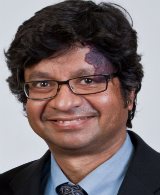 Dr. Ajith Amerasekera is a TI Fellow and IEEE Fellow in TI’s High Performance Analog division. After receiving his Ph.D. in 1986, he worked at Philips Research Labs, Eindhoven, The Netherlands, on the first submicron semiconductor development. He joined Texas Instruments, Dallas, in 1991 working in the VLSI Design Labs on device and circuit modeling, as well as working on new process nodes and circuit design techniques. He has focused on high speed, high data rates, and ultra low power circuit techniques for TI’s wireless products, network solutions, and digital signal processors, as well as working with SUN Microsystems on their SPARC processors implemented in TIs process technology. In 2008 he became the founding director of TI’s Kilby Research Labs where he was responsible for creating the research processes to address long-term exploration and innovation for new markets and technologies. He returned to the high performance analog business division in 2012 as the Chief Technical Officer. Ajith has 30 issued patents, and has published over 100 papers in technical journals and conferences, as well as 4 books on integrated circuits.
Dr. Ajith Amerasekera is a TI Fellow and IEEE Fellow in TI’s High Performance Analog division. After receiving his Ph.D. in 1986, he worked at Philips Research Labs, Eindhoven, The Netherlands, on the first submicron semiconductor development. He joined Texas Instruments, Dallas, in 1991 working in the VLSI Design Labs on device and circuit modeling, as well as working on new process nodes and circuit design techniques. He has focused on high speed, high data rates, and ultra low power circuit techniques for TI’s wireless products, network solutions, and digital signal processors, as well as working with SUN Microsystems on their SPARC processors implemented in TIs process technology. In 2008 he became the founding director of TI’s Kilby Research Labs where he was responsible for creating the research processes to address long-term exploration and innovation for new markets and technologies. He returned to the high performance analog business division in 2012 as the Chief Technical Officer. Ajith has 30 issued patents, and has published over 100 papers in technical journals and conferences, as well as 4 books on integrated circuits.
Sumedha Jayasena
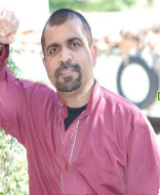 Prof. Sumedha Jayasena obtained his PhD at Lehigh University in the Field Of Biochemistry and BSc at University of Colombo in the field of Chemistry. His school education was at Nalanda College.
Prof. Sumedha Jayasena obtained his PhD at Lehigh University in the Field Of Biochemistry and BSc at University of Colombo in the field of Chemistry. His school education was at Nalanda College.
He is an accomplished research scientist and a manager capable of building and managing effective research teams with comprehensive experience over 25 years in Biotechnology and Pharmaceutical Industry. He has twenty-nine patents issued worldwide with many having significant commercial impact in both therapeutics and diagnostics. He has expertise in Genomics, Oligonucleotide therapeutics and diagnostics, Oncology, Biomarkers, RNA interference (RNAi) applications (siRNA- miRNA-based therapeutics), Gene Editing, Grant writing, and IND submissions.
Preethi Gunarathna
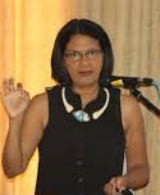 Prof. Preethi Gunaratne, Director, NextGen Sequencing Center and Associate Professor in Biology & Biochemistry at the University of Houston (UH) holds dual appointments in the Department of Pathology, Human Genome Sequencing Center (Baylor-HGSC) and Dan L. Duncan Cancer Center at Baylor College of Medicine (BCM). She obtained her Ph.D. in Genetics from Cornell University. Dr. Gunaratne currently serves as the microRNA expert on the NCI-The Cancer Genome Atlas (TCGA), NHGRI-Zebrafinch and Primate Genome Sequencing Consortia. In 2000 she served as Director of gene sequencing at Baylor-HGSC for the International Human Genome Project (IHGP) and made the largest single contribution of 15,000 sequences to the Mammalian Gene Collection (MGC). In 2005 Dr. Gunaratne joined UH and established the first functional genomics platform for decoding the noncoding genome to elucidate the role of microRNAs in cancer, schizophrenia, asthma/COPD/emphysema, song response in the auditory forebrain of songbird, placenta and brain of marmoset and avian flu virus. To rapidly translate the findings into clinical practice. Dr. Gunaratne founded NEXTmiRNA Technologies, a company dedicated to developing tumor suppressor microRNAs for cancer. Dr. Gunaratne is a co-author on 80 original articles, an inventor/co-inventor on 7 US patent applications, a review editor for the journal ‘Frontiers in Non-Coding RNAs’ and reviewer for 20 journals and 10 grant review panels including NIH, National Health and Medical Research Council (NHMRC) Australia and Cancer Research UK.
Prof. Preethi Gunaratne, Director, NextGen Sequencing Center and Associate Professor in Biology & Biochemistry at the University of Houston (UH) holds dual appointments in the Department of Pathology, Human Genome Sequencing Center (Baylor-HGSC) and Dan L. Duncan Cancer Center at Baylor College of Medicine (BCM). She obtained her Ph.D. in Genetics from Cornell University. Dr. Gunaratne currently serves as the microRNA expert on the NCI-The Cancer Genome Atlas (TCGA), NHGRI-Zebrafinch and Primate Genome Sequencing Consortia. In 2000 she served as Director of gene sequencing at Baylor-HGSC for the International Human Genome Project (IHGP) and made the largest single contribution of 15,000 sequences to the Mammalian Gene Collection (MGC). In 2005 Dr. Gunaratne joined UH and established the first functional genomics platform for decoding the noncoding genome to elucidate the role of microRNAs in cancer, schizophrenia, asthma/COPD/emphysema, song response in the auditory forebrain of songbird, placenta and brain of marmoset and avian flu virus. To rapidly translate the findings into clinical practice. Dr. Gunaratne founded NEXTmiRNA Technologies, a company dedicated to developing tumor suppressor microRNAs for cancer. Dr. Gunaratne is a co-author on 80 original articles, an inventor/co-inventor on 7 US patent applications, a review editor for the journal ‘Frontiers in Non-Coding RNAs’ and reviewer for 20 journals and 10 grant review panels including NIH, National Health and Medical Research Council (NHMRC) Australia and Cancer Research UK.
S. Ravi P. Silva
 After his secondary education in Sri Lanka Prof. S. Ravi P. Silva joined the Engineering Department at Cambridge University for his undergraduate and postgraduate work. He was a recipient of Cambridge Commonwealth Trust Fellowship while at Cambridge and member of Clare College. Ravi Silva is the Director of the Advanced Technology Institute (ATI) and Heads the Nano-Electronics Centre (NEC), which is an interdisciplinary research activity.
After his secondary education in Sri Lanka Prof. S. Ravi P. Silva joined the Engineering Department at Cambridge University for his undergraduate and postgraduate work. He was a recipient of Cambridge Commonwealth Trust Fellowship while at Cambridge and member of Clare College. Ravi Silva is the Director of the Advanced Technology Institute (ATI) and Heads the Nano-Electronics Centre (NEC), which is an interdisciplinary research activity.
His research interests encompass a wide range of activities. Nanotechnology and renewable being two underlying themes that thread through a plethora of fields that include solar cells, energy materials, carbon electronics, transistor designs & simulations, OPV, OLEDs, CNT, Graphene, SGT, CFRP, DLC, nano-biotechnology, nano carbons, nanotechnology, water technology, large area electronics, electronic and photonic devices. His research has resulted in over 600 presentations at international conferences, and over 550 journal papers, Over 15,000 citations (Google Scholar), and a Google H-factor of 64.
In 2003 the largest EPSRC Portfolio award for £6.68M was awarded to Prof. Silva and his team on Integrated Electronics which examined nano scale design features on the optical and photonic device properties. In 2004 by a SRIF award for £4M to set up a Nano-Electronics Centre for multidisciplinary research was awarded and allowed the enhancement of nano-bio activities via the EU Sensation and EU Carbio programme. In 2016, Government of Sri Lanka award Presidential Award to him in recognition for many contributions in the field of nanotechnology. In 2016, he was elected to a Visiting Professorship at Dalian Technology University, China. In April 2017, he was appointed as Honorary Director to the Zengzhou Materials Genome Institute (ZMGI) in China.






